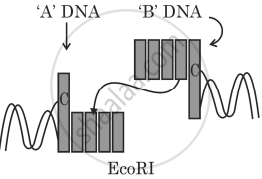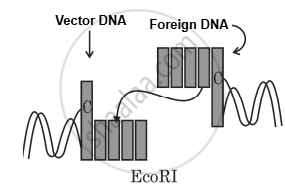Advertisements
Advertisements
Question

The schematic representation as above is showing the linking of two DNA fragments.
- Name ‘A’ and ‘B’ fragments. [1]
- Write the ‘palindrom’ recognised by EcoRI. [1]
- Where does EcoRI cut the palindrome? Write the events followed thereafter to form a recombinant DNA. [1]
Long Answer
Solution

- A is vector DNA and B is foreign DNA.
- The specific palindromic sequence recognised by EcoRI is
5' - GMTTC - 3'
3' - CTTMG - 5' - EcoRI makes 4 nucleotide sticky ends with AATT's 5' end overhangs. The sequence in the nucleic acid that the enzyme cuts is G↓AATTC, and the sequence that goes with it is CTTAA↓G.
The following things happen to make recombinant DNA after EcoRI cuts the DNA:- Digestion of DNA: EcoRI cuts both the donor DNA (which has the gene or sequence that is wanted) and the recipient DNA (which is a vector) at certain recognition spots.
-
- Mixing of Donor and Recipient DNA: The donor DNA, which has the gene of interest, and the receiver DNA, which is a vector.
- Annealing of Sticky Ends: Base pairing makes the complementary sticky ends of the donor DNA and the receiver DNA join together, which is also known as annealing. The hydrogen bonds are made between the patterns that are opposite each other.
- DNA Ligase Activity: The DNA ligase enzyme helps the sugar-phosphate backbones of the donor DNA and the receiver DNA join together to form phosphodiester bonds. This joins the DNA strands together, making units of recombinant DNA.
shaalaa.com
Is there an error in this question or solution?
